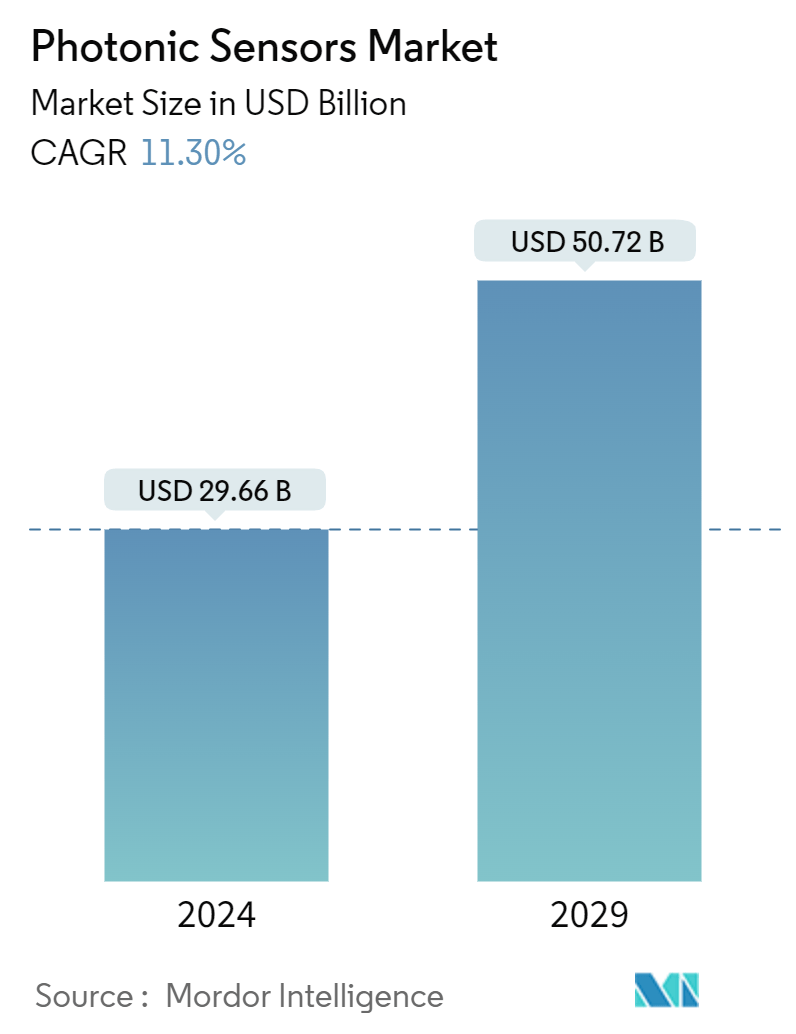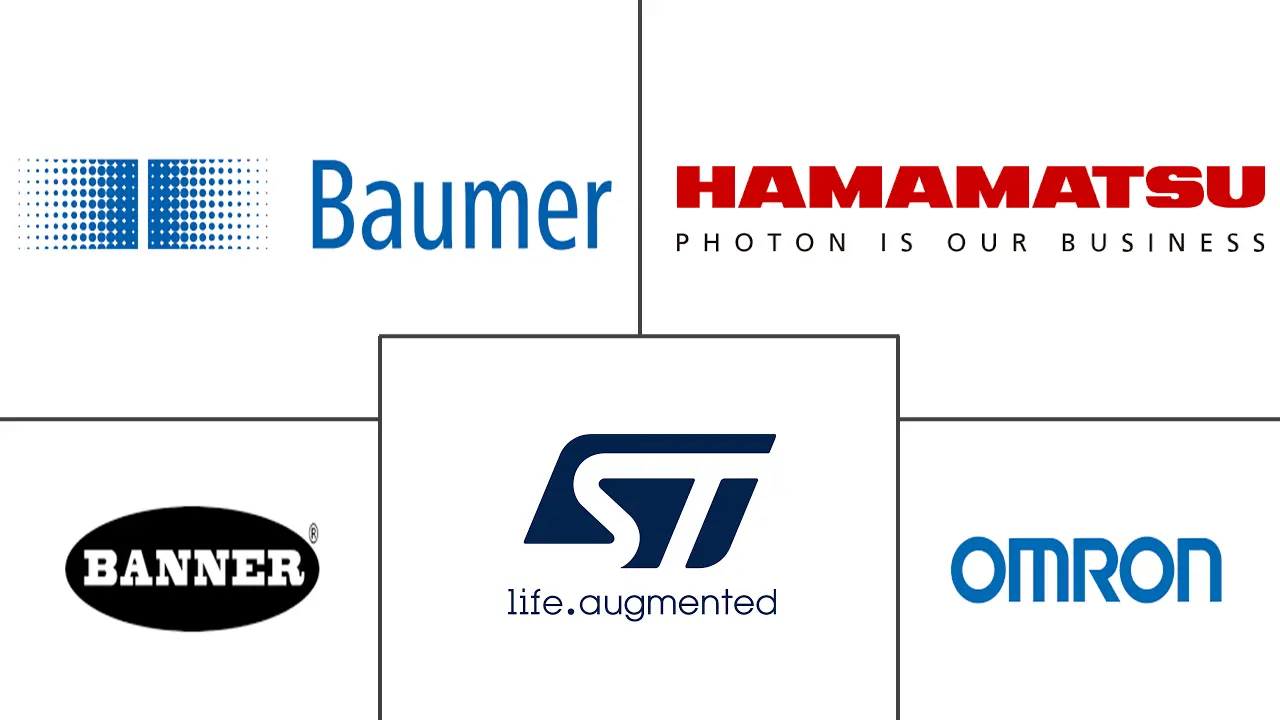Market Size of Photonic Sensors Industry

| Study Period | 2019 - 2029 |
| Market Size (2024) | USD 29.66 Billion |
| Market Size (2029) | USD 50.72 Billion |
| CAGR (2024 - 2029) | 11.30 % |
| Fastest Growing Market | Asia Pacific |
| Largest Market | Asia Pacific |
| Market Concentration | Medium |
Major Players
*Disclaimer: Major Players sorted in no particular order |
Photonic Sensor Market Analysis
The Photonic Sensors Market size is estimated at USD 29.66 billion in 2024, and is expected to reach USD 50.72 billion by 2029, growing at a CAGR of 11.30% during the forecast period (2024-2029).
Photonic sensors are crucial in industrial processes and are used in devices like fiber optic communication systems, laser-based medical instruments, environmental sensors, and optical detectors.
- These sensors offer advantages, including high sensitivity, fast response times, and immunity to electromagnetic interference. They also enable non-contact measurements, have a wide dynamic range, and are suitable for various applications, from telecommunications to medical imaging and environmental monitoring. Additionally, photonics sensors often exhibit lower power consumption and can function in harsh environments, making them versatile and efficient in diverse fields.
- With the growing adoption of autonomous cars, precision metrology has gained significant importance with advancements in the global positioning system (GPS), which relies on precision timing. Photonic sensors are being viewed as a suitable technology for GPS and can benefit the budding autonomous car industry, thereby creating significant demand over the forecast period.
- Increasing requirements for security and safety drive the demand for photonics sensors primarily due to their ability to provide high precision, rapid detection, and non-intrusive monitoring in various applications, including aerospace and defense, transportation, manufacturing, healthcare, energy and power, and many others.
- Photonic sensors are slowly witnessing commercial acceptance. However, there are few established standards for their operation. Photonic sensors also use numerous technologies, such as laser, fiber optics, and biophotonic. These technologies are distinct from each other and lack compatibility. Lack of awareness, less acceptability, and the unjustifiable image quality offered by the sensors may also hinder market growth. The imbalance between image quality and price has led to increased competition and peer pressure regarding optimal pricing.
- The U.S. and China dispute has prompted a shift in investments, with countries like India and select Southeast Asian nations emerging as attractive destinations for manufacturing and industrial ventures. This shift is mainly due to Chinese companies seeking to broaden their manufacturing footprint. These evolving dynamics are poised to create new avenues within the studied market. Furthermore, heightened expenditures in end-user industries are set to bolster the growth of photonic sensors in the coming years. IHME projects a significant increase in global health spending, estimated to reach USD 1,515 (2.050 PPP dollars) per person by 2050.
Photonic Sensor Industry Segmentation
The photonic sensor senses light and converts it to an electric signal. Photonic sensing technology integrates light emission, detection, and transmission through fiber optics and optical components. Photonic sensors are used in many applications, such as lidar, ladar, laser-induced fluorescence (LIF), calorimetry, scintillation detection, spectroscopy, and biological fluorescence detection.
The photonic sensors market is segmented by product type (fiber optic sensors, biophotonic sensors, image sensors, and other product types), end-user industry (aerospace and defense, automotive, industrial, healthcare, energy and power, consumer electronics, and other end-user industries), and geography (North America, Europe, Asia-Pacific, and the Rest of the World). The report offers the market size in value terms in USD for all the abovementioned segments.
| By Product Type | |
| Fiber Optic Sensors | |
| Image Sensors | |
| Biophotonic Sensors | |
| Other Product Types |
| By End-user Industry | |
| Aerospace and Defense | |
| Automotive | |
| Industrial | |
| Healthcare | |
| Energy and Power | |
| Consumer Electronics | |
| Other End-user Industries |
| By Geography | |
| North America | |
| Europe | |
| Asia | |
| Australia and New Zealand | |
| Latin America | |
| Middle East and Africa |
Photonic Sensors Market Size Summary
The photonic sensors market is poised for significant growth, driven by their critical role in various industrial and consumer applications. These sensors, integral to technologies such as fiber optic communication systems, laser-based medical instruments, and environmental monitoring devices, offer benefits like high sensitivity, rapid response times, and immunity to electromagnetic interference. Their ability to enable non-contact measurements and function in harsh environments makes them versatile across sectors including telecommunications, medical imaging, and environmental monitoring. The increasing adoption of autonomous vehicles and advancements in GPS technology further bolster the demand for photonic sensors, highlighting their importance in precision metrology. Additionally, the rising need for security and safety across industries such as aerospace, defense, and healthcare fuels the market's expansion.
The consumer electronics sector also significantly contributes to the photonic sensors market, with applications in smartphones, tablets, and wearable devices enhancing user experience and device functionality. These sensors are crucial for features like touchscreens, ambient light detection, and secure authentication methods such as iris scanning and fingerprint sensing. The growing popularity of smart home devices and the increasing urbanization and health awareness among the population further stimulate market growth. Regionally, Asia-Pacific is expected to experience substantial growth due to rising defense spending and industrial automation trends in countries like China and India. The market is semi-consolidated, with key players employing strategies like joint ventures and new product launches to strengthen their market presence.
Photonic Sensors Market Size - Table of Contents
-
1. MARKET INSIGHTS
-
1.1 Market Overview
-
1.2 Industry Value Chain Analysis
-
1.3 Industry Attractiveness - Porter's Five Forces Analysis
-
1.3.1 Bargaining Power of Suppliers
-
1.3.2 Bargaining Power of Buyers
-
1.3.3 Threat of New Entrants
-
1.3.4 Threat of Substitutes
-
1.3.5 Intensity of Competitive Rivalry
-
-
1.4 Impact of COVID-19 Aftereffects and Other Macroeconomic Factors on the Market
-
-
2. MARKET SEGMENTATION
-
2.1 By Product Type
-
2.1.1 Fiber Optic Sensors
-
2.1.2 Image Sensors
-
2.1.3 Biophotonic Sensors
-
2.1.4 Other Product Types
-
-
2.2 By End-user Industry
-
2.2.1 Aerospace and Defense
-
2.2.2 Automotive
-
2.2.3 Industrial
-
2.2.4 Healthcare
-
2.2.5 Energy and Power
-
2.2.6 Consumer Electronics
-
2.2.7 Other End-user Industries
-
-
2.3 By Geography
-
2.3.1 North America
-
2.3.2 Europe
-
2.3.3 Asia
-
2.3.4 Australia and New Zealand
-
2.3.5 Latin America
-
2.3.6 Middle East and Africa
-
-
Photonic Sensors Market Size FAQs
How big is the Photonic Sensors Market?
The Photonic Sensors Market size is expected to reach USD 29.66 billion in 2024 and grow at a CAGR of 11.30% to reach USD 50.72 billion by 2029.
What is the current Photonic Sensors Market size?
In 2024, the Photonic Sensors Market size is expected to reach USD 29.66 billion.

